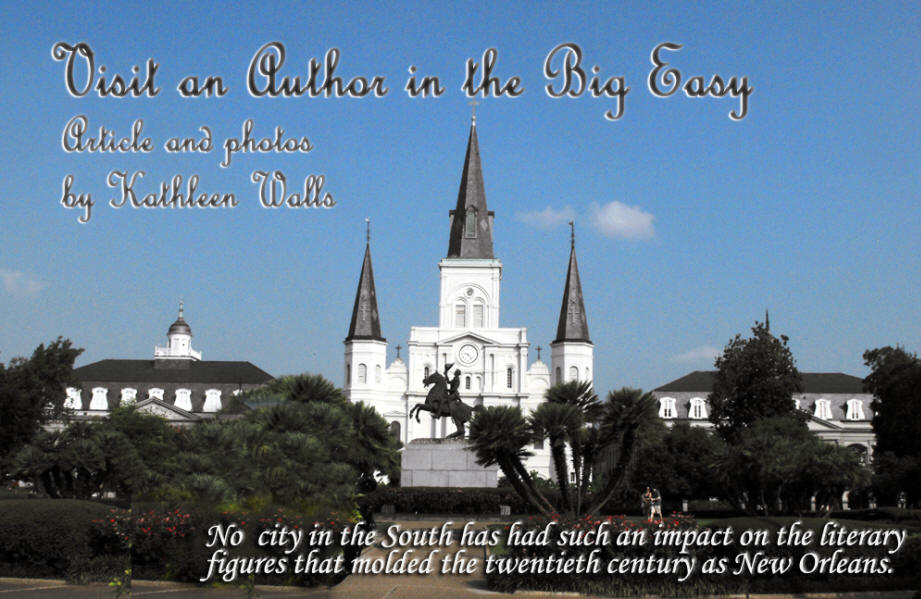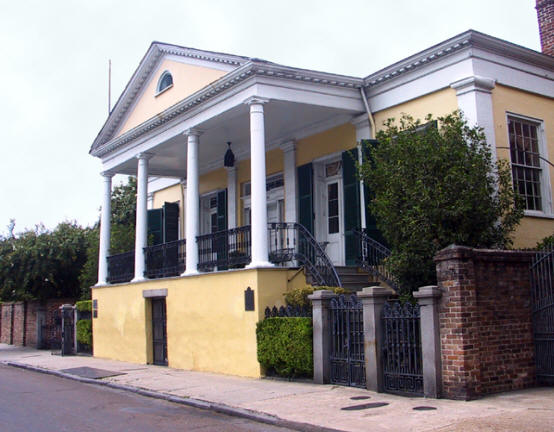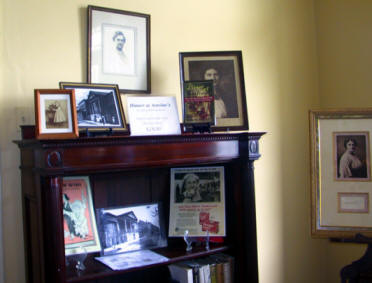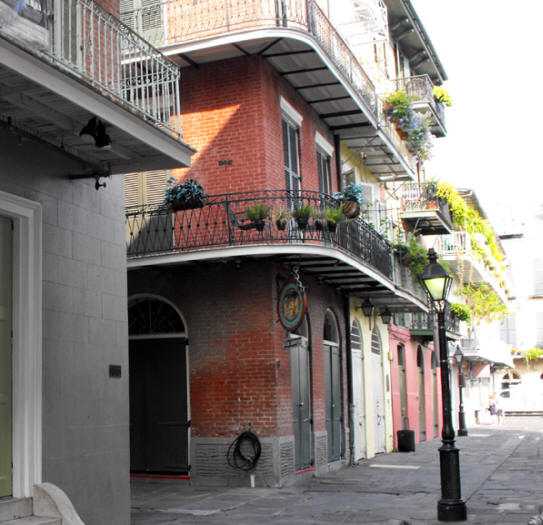
Next
time you visit New Orleans, take yourself on a "Writer's Tour"
and visit some of the places made famous by the greatest
literary minds of their time.
Here are some of my favorites.
 |
| Beauregard-Keys House |
Francis Parkenson Keys
was born Frances
Parkinson Wheeler in Charlottesville, Virginia. She
married Henry W. Keyes a
U.S. Senator and later governor or New Hampshire. After his
death in 1938, Keys wrote prolifically.
In the 1950s, she purchased the former
Beauregard House at
1113 Charters Street in New Orleans. Madame Castel's Lodger
is a fictionalized biography of General P. G. T. Beauregard who
lived in the home but never owned it. Her book, The Chess
Players, is a fictionalized biography of another former
tenant of the home, chess master Paul Morphy.
Her home is now a museum preserving her heritage and that
of General Beauregard
(For
more about the home click here)
 |
| Display of Keys' books in home |
Many of her Louisiana novels are related by common background
and characters that recur in different novels.
Keyes died in 1970, at the age of 84, in
New Orleans Some of her Louisiana noivels are Crescent
Carnival (1942), The River Road (1945), Came a Cavalier (1947),
Dinner at Antoine's (1948), Blue Camellia (1957), The Chess
Players: A Novel of New Orleans and Paris (1960) and Madame
Castel's Lodger (1962).
Tennessee Williams lived in New Orleans at
722 Toulouse in 1938. It is the setting of his 1977 play
Vieux Carre.
Although his famous
A
Streetcar Named Desire was
written in Chapala, Mexico, nine years later, it clearly
reflects his New Orleans experience.
Born in Mississippi, Williams came to New
Orleans to write for the WPA. His earlier years had been a
succession of unsuccessful jobs. New Orleans suited him. There
he worked as a waiter to supplement the meager pay his writing
earned in those early days. In 1944 he commented in a newspaper
interview, "My salaries have ranged from $50 a month to $250 a
week but I preferred the $50 job because it enabled me to live
in New Orleans."
By
1957 he had reached the pinnacle of his success as a playwright.
He recalled his surjourn in New Orleans as a happy time.
An article in
Tennessean Magazine
quoted him as saying: " New Orleans is my favorite city of
America . . . of all the world, actually."
By 1959 he had earned two Pulitzer Prizes,
three New York Drama Critics' Circle Awards, three Donaldson
Awards, and a Tony Award. In 1979, four years before his death,
he was inducted into the American Theater Hall of Fame.
Besides the Toulose St residence he lived
at several other eplaces in New Orleans: 429 Royal St., 632 St.
Peter St. and 1014 Dumaine St. None of his residences are
open to the public.
His
best works were plays, many later converted to movies. Some of
my favorites are
A Streetcar Named Desire
(1947), Cat on a Hot Tin
Roof, (1955) Orpheus
Descending (1957),
Sweet Bird of Youth (1959) and
The Glass Menagerie
(1944),
 |
| 624 Pirate's Alley |
William Faulkner,
Like Tennessee Williams was born in Mississippi however he lived
at 624 Pirate's Alley when he wrote his first novel,
Soldiers' Pay in 1925.
The house is a three-story, narrow building with wrought
iron alcoves that today houses
Faulkner House Books on
ground floor and private apartment above.
Falkners description of the house reads " .
. . [it] faces the garden behind St. Louis Cathedral. The
Catholics, you know, have a Mass each hour . . . Across the
garden is the house where the priests live . . . The nuns live
in a wing of the same house--a convent. Between Masses the
little choir boys in their purple robes and white surplices play
leapfrog in the garden, yelling and cursing each other, then go
back inside and sing like angels."
By 1930, his writing brought him enough
income to buy a house in Oxford for his family to live in, which
he named "Rowan Oak." (click here for more about Rowan Oaks)
As a youth, he was heavily influenced by
war stories he heard from the old men of Oxford and the stories
told to him by Mammy Callie, his African American caretaker
about events in the Civil War, slavery, the Ku Klux Klan, and
the Falkner family. Faulkner's grandfather was also a strong
influence with tales of William's great-grandfather, for whom he
was named, William Clark Falkner, a businessman, writer, and
Civil War soldier. Thus
is is no wonder his most famous works are novels and short
stories set in the fictional Yoknapatawpha County, which was
based on Lafayette County, Mississippi, where he grew up.
Some of his best know work
includes A Fable
(1954), The Reivers
(1962), Absalom, Absalom
(1936),
The Sound and the Fury
(1929) , As I Lay
Dying (1930) and
Light in August (1932).
 |
| 711 Royal |
Truman Capote was
born in New Orleans in 1924. He claimed to be born at the Hotel
Monteleon and the
hotel later named a suite in his honor. However when I visited
the Monteleon and interviewed Andrea Thornton, then director of
Sales and Marketing, she told me, "Capote was actually born at
Touro Infirmary."
Writers with troubled souls
seemed especially drawn to the Monteleone.
(For more about
the Monteleon click here) William Faulkner,
Tennessee Williams, Truman Capote and Ernest Hemingway all spent
time there. Williams immortalized the hotel in his
The Rose Tattoo.
Because of its strong literary heritage, Friends of Libraries
USA designated the hotel a Literary Landmark. Only three other
hotels share this honor; New York City's Plaza and Algonquin
hotels and San Antonio's Menger Hotel.
Capote's 17 year old mother, Nina, and
first husband, Archulus Persons, did live at the hotel at the
time of his birth. Capote had a very traumatic childhood and
claimed to have been locked in the suite at the hotel
where he would scream and cry to be let out.
He also recounted an episode
of being lost at Mardi
Gras when he was 5 years old and spending the night at the
police station before his mother retrieved him the next morning.
Capote was never a fan of Mardi Gras in later life. The family
soon moved to 1801 Roberts Street, on the other side of town.
When Capote was very young his parents divorced and he was sent
to Monroeville, Alabama to live with her family.
He began writing seriously at the age of 11
and at 19 returned to New Orleans and rented an apartment at
711 Royal. It was here he began his first
semi-autobiographic novel,
Other Voices, Other Rooms.
The novel in part tells of a young boy coming to terms with his
homosexuality.
He returned to New Orleans many times
throughout his life and In a 1981 interview by
People, he is asked,
"Why doesn't he move back to his beloved New Orleans? 'Well,
when Oscar Wilde was leaving England, someone said to him, 'Why
don't you go live in Venice? You've always loved it so.' He
said: 'What? And be a monument to tourists?' Well,' concludes
Capote, 'that's the way I feel about New Orleans.'"
His most famous books are
Other Voices, Other Rooms
(1848), Breakfast at Tiffany's (1948) and
In Cold Blood
(1965).
George Washington Cable (October 12, 1844 – January 31,
1925) His home at 1313
8th Street, in the Garden District He lived there in 1874 to
1884 and was known to have entertained his friend, Mark Twain,
there. The house was named a National Historic Landmark in 1962.
He is best known for his portrayals of
Creole life in New Orleans, Louisiana. Often called "the most
important southern artist working in the late 19th century, as
well as the first modern southern writer," his work is
considered to foreshadow William Faulkner. His books revolved
around racism, mixed-race families and miscegenation. Although
he had served in the Confederate Army and came from a
slaveholding family, his works dealt with inequality and Jim
Crow laws. Because of his stand on racial equality, he moved
away from New Orleans to
Massachusetts and later Florida.
 |
| Anne Rice home |
Think of vampires and the first name that comes to mind is
Anne Rice.
Anne, who's birth name
was Howard Allen Frances O'Brien, was born in New Orleans. She
and her family lived in the rented home of her maternal
grandmother, Alice Allen, at 2301 St. Charles Avenue in the
Garden district. She remained in New Orleans until the age of
sixteen when her father moved the family to north Texas after
her mother's death and his remarriage.
She began using the name "Anne" on her
first day of school. One of her
teachers asked her what her name was. She told the nun "Anne"
and she remained "Anne"
to everyone she knew. In 1947, she legally changed her name to
"Anne."
She married Stan Rice in Denton, Texas,
shortly after her twentieth birthday. She wrote
Interview With The
Vampire which
was published in 1976. Much of the book is set in New Orleans.
In 1988, Anne and her husband purchased 1239 First St. In the
old Irish Channel section and returned to New Orleans.
She remained there until 2004 when she decided to leave New
Orleans following the death of her husband. On January 30, 2004,
Rice put the largest of her three homes up for sale and moved to
a gated community in Kenner, Louisiana. She cited, "Simplifying
my life, not owning so much, that's the chief goal, I'll no
longer be a citizen of New Orleans in the true sense."/p>
In 2014 she published Prince Lestat the
eleventh book in her Vampire series and is currently working on
the next one, Blood
Paradise. ShShe currently lives in California in order to be
closer to her son.
So many other great writers have ties to the Crescent City
including Lillian Hellman, So many other great writers
have ties to the Crescent City including Lillian Hellman, F.
Scott Fitzgerald, Walker Percy and others that this article
could go on forever. Instead why not go visit the City That Care
Forgot and search out New Orleans literary connections for
yourself.
For More Info:
http://www.neworleanscvb.com/press-media/story-ideas/literary-new-orleans/
|
![]() Ads fund American Roads so please consider them for your needed
purchases.
If you enjoy the articles we offer, donations
are always welcome.
Ads fund American Roads so please consider them for your needed
purchases.
If you enjoy the articles we offer, donations
are always welcome.
----------
|